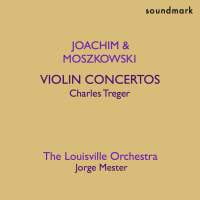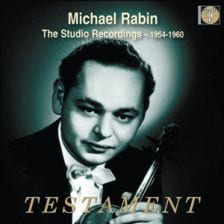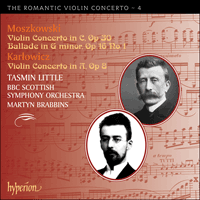In the latest issue of Gramophone, Jeremy Nicholas wrote an article about “Forgotten Romantic violin concertos” and the value of unearthing them for presentation to concert and media audiences. In his article, he highlights works by Polis composers Moritz Moszkowski, Henryk Wieniawski and Mieczysław Karłowicz. Below are highlights from the article:
 Moszkowski – Violin Concerto (Soundmark Records: 48238): Moritz Moszkowski was a German-Jewish composer, pianist, and teacher of Polish descent on his paternal side, who was born in 1854 in Breslau (now Wrocław, Poland). His Violin Concerto, “with its coherent large-scale structure, skilful [sic!] orchestration and wealth of melodic invention – contradicts the view that Moszkowski merely wrote salon trifles.”
Moszkowski – Violin Concerto (Soundmark Records: 48238): Moritz Moszkowski was a German-Jewish composer, pianist, and teacher of Polish descent on his paternal side, who was born in 1854 in Breslau (now Wrocław, Poland). His Violin Concerto, “with its coherent large-scale structure, skilful [sic!] orchestration and wealth of melodic invention – contradicts the view that Moszkowski merely wrote salon trifles.”
 Wieniawski – Violin Concerto No 1 (Testament SBT61471): Henryk Wieniawski was born on July 1835 in Lublin, Poland, and wrote this Concerto at the age of 17, just after completing his composition studies at the Paris Conservatory. “[The first Violin Concerto] has never rivalled the popularity of his Concerto No 2 in D minor, but with several high-profile champions on disc, No 1 in F sharp minor should be better known to a wider audience. To my mind, Rabin with Boult in 1957 is one of the great recordings of a Romantic violin concerto, the epitome of all one expects from such a work – electrifying, moving, magisterial, exultant.”
Wieniawski – Violin Concerto No 1 (Testament SBT61471): Henryk Wieniawski was born on July 1835 in Lublin, Poland, and wrote this Concerto at the age of 17, just after completing his composition studies at the Paris Conservatory. “[The first Violin Concerto] has never rivalled the popularity of his Concerto No 2 in D minor, but with several high-profile champions on disc, No 1 in F sharp minor should be better known to a wider audience. To my mind, Rabin with Boult in 1957 is one of the great recordings of a Romantic violin concerto, the epitome of all one expects from such a work – electrifying, moving, magisterial, exultant.”
 Karłowicz – Violin Concerto (Hyperion CDA67389): Mieczysław Karłowicz began his studies as a violinist but, after a few years, poor health (both mental and physical) forced him to give up the violin and he turned quickly to composition. His compositions were most representative of ‘Młoda Polska’ [Young Poland], the artistic movement based on the idea of a unification of modernistic tendencies and national tradition initiated by Różycki, Fitelberg, Szymanowski, and Szeluto. “The writing of this earworm concerto, though, shows how well he knew the instrument, placing considerable technical demands on the soloist. Tasmin Little tosses these aside with her customary aplomb, but it’s the central Romanza, providing an oasis of lyrical calm, that really grabs the attention.”
Karłowicz – Violin Concerto (Hyperion CDA67389): Mieczysław Karłowicz began his studies as a violinist but, after a few years, poor health (both mental and physical) forced him to give up the violin and he turned quickly to composition. His compositions were most representative of ‘Młoda Polska’ [Young Poland], the artistic movement based on the idea of a unification of modernistic tendencies and national tradition initiated by Różycki, Fitelberg, Szymanowski, and Szeluto. “The writing of this earworm concerto, though, shows how well he knew the instrument, placing considerable technical demands on the soloist. Tasmin Little tosses these aside with her customary aplomb, but it’s the central Romanza, providing an oasis of lyrical calm, that really grabs the attention.”
[Source: gramophone.co.uk]
